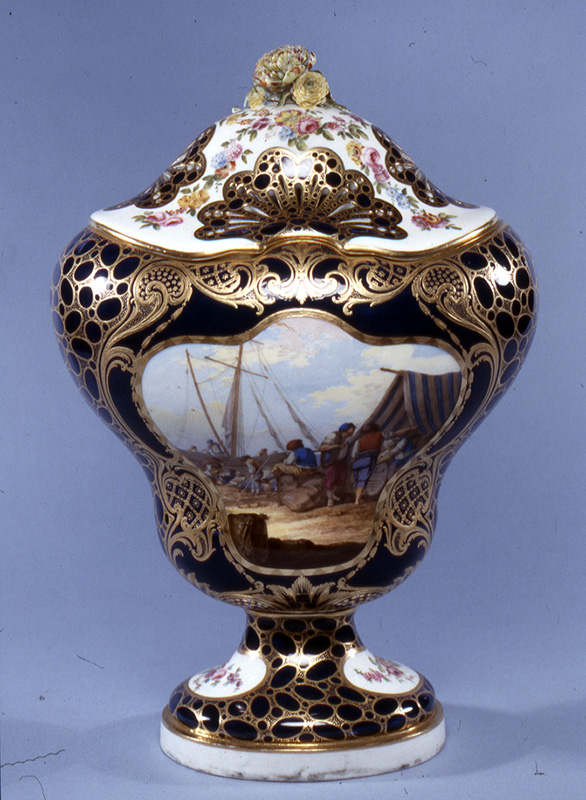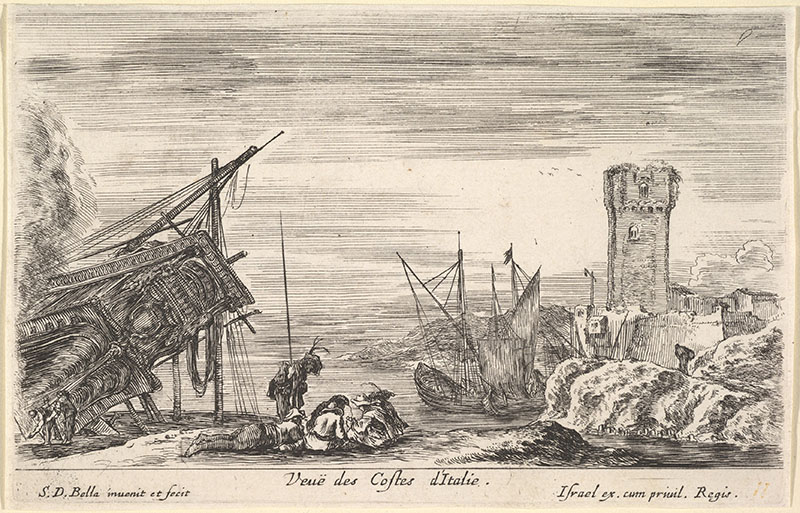18th-Century Marine Imagery in the Sèvres Archive
by Alyse Muller
This summer, a Decorative Arts Trust Research Grant provided me the opportunity to conduct essential research at the Sèvres manufactory archive in Paris. My dissertation reconsiders the marine genre within a variety of mediums to explore the nexus of maritime commerce, political aspirations, iconography, and aesthetics. The fifth chapter juxtaposes two groups of Sévres ceramics against a narrative of the royal porcelain manufactory. This chapter begins with Jean-Claude Duplessis’s pot-pourri à vaisseau, of interest for the form’s unique and technically difficult shape and the evolution of its painted subject matter. The scene depicted in the reserve changed throughout its short-lived production (1757/8–64) with later iterations illustrating more complex genre scenes, such as the quayside view on a version at the Walters Museum of Art (figure 1). These pot-pourri ships and a second group of objects featuring a series of port scenes (figure 2) by Sèvres painter Jean-Louis Morin and the head of the painter’s studio, Jean-Baptiste-Etienne Genest, were the primary focus of my work this summer.
The Sèvres archive contains information on the manufactory process, patronage records, correspondence, personnel files, ledgers, and an image library from the 18th century to the present. My goal was to establish a better understanding of the archive’s content while simultaneously gathering more data on individual objects. For the porcelain painters Genest and Morin, I explored the ways in which the yearly payroll changed in terms of compensation and structure. This inquiry created questions about the monetary value of porcelain painting versus paintings on canvas, as well as the importance given to subjects on porcelain forms. Strikingly, “Marine” is clearly differentiated as its own category of subject in both the manufactory’s 18th-century image archive and the production records, which note individual artist’s work by genre. For instance, under Genest’s name, it specifies how many marine works he produced in a given year. Under the term “decorations,” the stock lists and manufactory sale lists also note subjects sporadically; however, “Marine” is often mentioned alongside “fleurs” and other designations.1
Another ongoing research topic is the origin of these port scenes. Likely emulating German porcelain Kauffahrtei (merchant shipping scenes), it has been posited that these views borrow from earlier Italian and French 17th-century sources. Geoffrey de Bellaigue, Juliet Carey, and Maureen Cassidy-Geiger in their analyses of the Sèvres sources and image archive have noted that artists did not always produce a direct copy of an image, but rather “mixed, matched and embellished.”2 Another explanation is that the scenes by Genest and Morin may in fact be entirely original, albeit emulating earlier works in the factory or a tranche of drawings the artists referenced when seeking inspiration (figure 3).
In the 18th century, the Sèvres ledgers occasionally noted designs and engravings either bought that year or in the possession of the manufactory. What was present in the inventory and the manner in which subjects were differentiated further illustrates how objects were classified and valued. For example, in a 1752 list of the designs and prints by different masters, “de Boucher” is noted for his “enfants” work as well as the “dessins de Gillot.” Moreover, for engravings “60 marines” are mentioned, which are differentiated from “payasges differens.” Of particular interest to my work is a reference to “Desseins de marine de M. Portail,” whom I have concluded is Jacques-André Portail (1695–1759). Few of his drawings survive, and I have not yet been able to track down a known marine work. They do, however, appear in other records of 18th-century collections.
Looking through the Collection of Graphic Arts, I discovered marine engravings that could have served as inspiration. Plates from Les differens Batimens de la Mer Mediterranée (1710–20) and works by Stefano della Bella’s Divers embarquements (1641–7), Paysages maritimes (1644), and Vues de ports de mar (1647, figure 4) survive, although scholars are uncertain which collections were bought in the 19th century for the manufactory and which survive from the 18th. Nonetheless, similar features appear in the existing porcelain port scenes as well as in two ink and wash renderings marked as by Genest.
In summary, a clearer picture of the interconnections of imagery was made possible by this productive visit, and I would like to thank Delphine Valmalle for her assistance navigating the archive. The time spent was invaluable for my dissertation research and understanding of the role of marine painting within the manufactory.
- Marine is often capitalized while fleurs is not.
- See Carey Juliet, “Peasants on Porcelain: Sèvres and the Taste for Teniers,” The French Porcelain Society Journal III (2007): 112. Also see Maureen Cassidy-Geiger, “’Engravings and Etchings in the Manufacture Nationale de Sèvres: An Introduction to the Collection Formed in the Eighteenth Century,” The French Porcelain Society Journal, 1999, 15–32; Geoffrey de Bellaigue, “Sèvres Artists and Their Sources I: Paintings and Drawings,” The Burlington Magazine 122, no. 931 (1980): 667–82; Geoffrey de Bellaigue, “Sèvres Artists and Their Sources II: Engravings,” The Burlington Magazine 122, no. 932 (1980): 748–62.
Alyse Muller is a doctoral candidate in Columbia University’s Department of Art History and Archaeology.
A print version of this article was published in The Magazine of the Decorative Arts Trust, one of our most popular member benefits. Join today!




